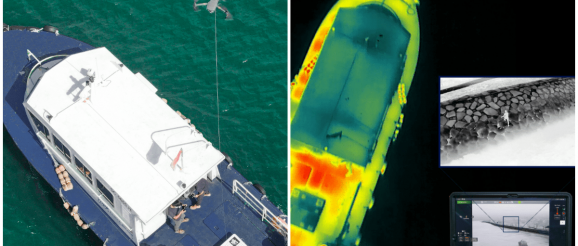Operate DJI Mavic 2 autonomously on boats with this drone innovation

Operating a drone from a moving boat can be a nerve-wracking experience for most pilots, especially since you don’t want your drone to end up in the water. Many operators rely on hand-catching the drone – a method that’s highly successful with the DJI Phantom 4 series that has its landing gear underneath the drone. But what about the more recent Mavic 2 drones?
Many patrol boats, used close to the shores around the world, have a small deck for launching and landing drones. For an inexperienced pilot, one wrong move could mean that the drone falls into the water. On the other hand, catching the drone with bare hands could put the operator in harm’s way.
This is a problem that Singapore-based company, Volarious, understands well, having worked closely with firefighters and police drone teams on land-based tethered drone systems. So now, Volarious has launched a new product called the V-Line Boat Mode so that the whole process of a DJI Mavic 2 drone taking off and following the vessel to land back onto it can be fully automated.
Stressing that the innovation will allow drone pilots to expand operational capacity in activities like harbor and inland waterways patrol, Weiliang Zhang, founder of Volarious, explains:
To enable this automated feature, users require a unique 1.2-meter square landing pad and the Volarious app. With one click of the button, the drone will take off and follow the vessel, allowing surveillance from a high angle. This allows a small patrol boat to efficiently observe its surroundings as well as much taller vessels. The V-Line system works especially well when paired with the new Mavic 2 Enterprise Advanced. The high-resolution thermal camera allows better observation of objects and people at night.
The V-Line Boat Mode tethered drone system can also be used in coastline surveillance as well as search and rescue operations. A drone can take off, follow, and land on small vessels autonomously while providing a real-time view of high-resolution thermal and RGB images and video streams.
In areas with 5G connectivity, a low latency live stream from the drone can be sent back to a command center, allowing for greater situational awareness and information sharing.
Not interested in keeping the drone tethered? Volarious points out that the system can work without the V-Line tether kit also, in which case, advanced vision algorithms guide the Mavic 2 drone to accurately land back onto a moving vessel. These algorithms automatically compensate for the drift and rocking motion of the vessel.
